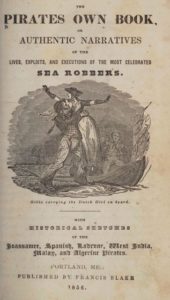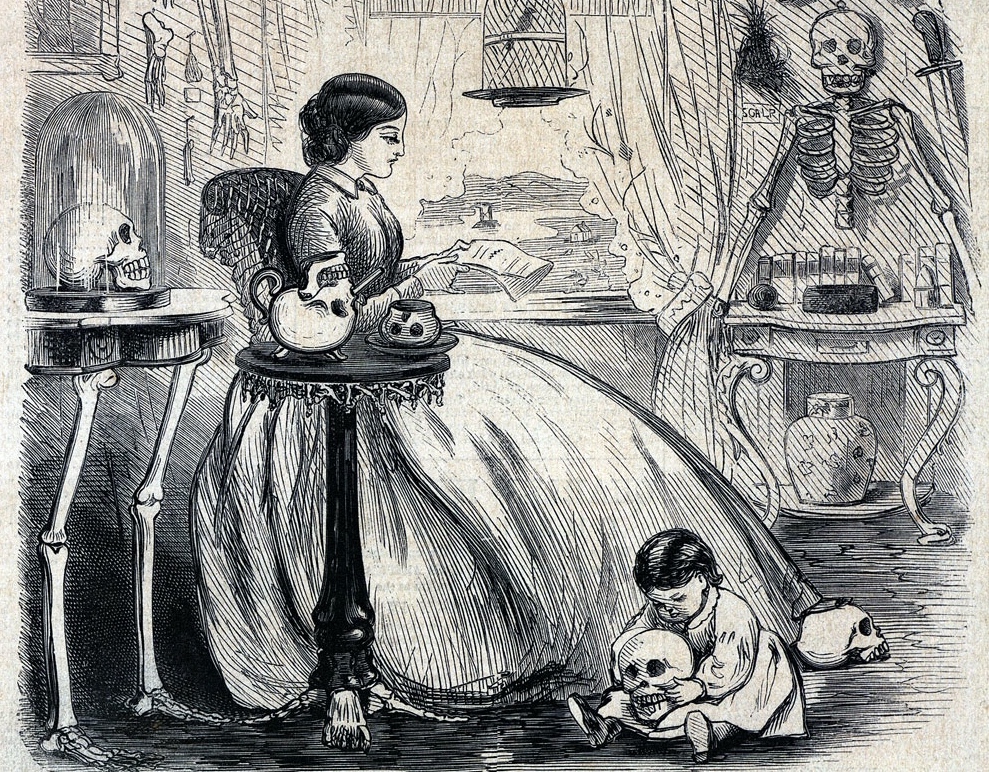As soon as it was published in 1837, The Pirates Own Book was a dangerous book—a powerful manual for acting the pirate and writing pirate tales. Compiled anonymously by Charles Ellms, this anthology of pirate biographies went through at least five imprints and editions in the first year and appeared for sale from Maine to Wisconsin. Scholars have guessed that in its first twelve months The Pirates Own Book sold some 6,000 copies at a dollar each. As evinced by the casual mention in mid-century newspapers as far away as Kansas and California, the title became a cultural touchstone. Even those who hadn’t read the volume had heard of it, for the book was thought to convert readers into real-life buccaneers. It also made historic swashbucklers into popular literary characters, paving the way for the fictional pirate stories to come. (Figure 1)
The Danger of The Pirates Own Book
By making pirate stories dramatic and exciting, Ellms transformed pirates from news objects and historical actors to distinctly literary characters.
To understand how Ellms’s book seemed to cause piracy, we can think about Julia Kristeva’s suggestive argument in Powers of Horror: some play out their fantasies by reading literature and are satisfied, but there is always the risk that others, enthralled by the literature, will take the pleasure of the text into the real world. Contemporaries believed that many readers were so inspired by Ellms’s pirate anthology. In 1842 the Captain of the U.S.S. Somers hanged three men for mutiny—one of them, Philip Spencer, was the Secretary of War’s son—after an onboard investigation. (Figure 2) As Commander McKenzie said in a Naval Court of Inquiry, Spencer’s literary tastes “proved” his intentions: “it was one of the amusements of Mr. Spencer, to relate to the young children . . . ‘murderous stories and tales of blood,’ that the chief and favorite theme of his conversation was piratical exploits, and the pleasures of a pirate’s life, and the great object of his ambition was renown as a pirate; that the book which he oftest read . . . was the ‘Pirates Own Book.’” In an 1841 Louisiana courtroom, where lawyers sought to prove charges of nautical piracy against Captain Daniel De Putron, they similarly pointed to the large stock of weapons and a copy of The Pirates Own Book that they had found on his ship. The title of Ellms’s anthology, which oddly lacks an apostrophe, was seen as prophetic: pirates owned the book.
Ellms offered something different from previous pirate chroniclers, making his collection particularly attractive for nineteenth-century readers. Pirates had long featured in newspapers like the eighteenth-century Boston News-Letter, the first regularly published newspaper in the English-speaking colonies. Pirates also appeared in pamphlets and in broadsides, a single printed sheet that served as a cheap form of entertaining news. As a 13-year-old printer’s apprentice in Boston, Benjamin Franklin penned and hawked a broadside ballad about Blackbeard shortly after that pirate’s death. Pirate ballads could have long lives: The Dying Words of Captain Robert Kidd, a beloved pirate ballad, was sung on ships, in taverns, and at camp revivals from Mississippi to Canada for almost two hundred years. (Figure 3) Over time, the lyrics shifted, even changing Kidd’s first name from William to Robert. Still, it and other pirate writings were broadly based in fact and intended to tell a historical, if stylized, story. Such remained true as pirates made their way into volumes, starting with A. O. Exquemelin’s Buccaneers of America (1678). Trained as a surgeon, Exquemelin shipped under the notorious pirate Captain Henry Morgan and then penned his account in Dutch; it was quickly translated (with various levels of faithfulness) into German (1679), Spanish (1681), and English (1684). Captain Charles Johnson (once assumed to be Daniel Defoe) followed in 1724 with the English-language General History of the Robberies and Murders of the Most Notorious Pyrates, another biographical account of Golden Age pirates that was likewise hastily translated, frequently reprinted, and widely read.
Coming a hundred years after Johnson, Ellms updated A General History by including more recent freebooters who tormented U.S. citizens or themselves had U.S. connections. Ellms tells how the vicious Edward “Ned” Low worked in a Massachusetts rigging house; Captain Avery considered settling in New England but needed to dispose of his diamonds first; Charles Gibbs ran a Boston grocery before turning pirate; and Captain Kidd was held in the Old Boston Gaol before being shipped to London and gibbeted. (Figure 4) The Algerine pirates and Barbary Corsairs, who get a section in The Pirates Own Book, attacked many early national ships off the coast of northern Africa. In response, an enraged Congress funded the creation of the U.S. Navy. Even as his miscellany ranged across time and space, then, Ellms continually connected piracy to the United States. Such was both a historic and timely link. New England Puritans had briefly welcomed pirates, and as early nineteenth-century readers would have known, piracy still existed in the Gulf of Mexico and the Caribbean Sea. In fact, the Republic of Texas outfitted privateers (pirates with the gloss of legality) starting in 1835. Ellms also pointed out that U.S. law classified the international slave trade as piracy. But although Congress made the act a capital offense in 1820, few were tried for the crime, and only one person was ever hanged—Nathaniel Gordon in 1862—despite estimates that annually as many as 15,000 people were smuggled into the United States. Piracy, Ellms’s introduction told U.S. readers, was all around them and often went unpunished.
Hence, while the United States officially condemned piracy, it was not above ignoring the piratical actions of its citizens or leveraging a pirate’s abilities. It most certainly did the latter with Jean Lafitte, who after plundering ships in the Indian Ocean and Caribbean Sea, established a pirate camp in Barataria, just outside New Orleans. In September 1814, during the War of 1812, a British commander invited Lafitte to join the King’s forces and attack Louisiana. The wily Lafitte pretended to be interested while awaiting a reply to his offer to defend Barataria for the Americans in return for amnesty. Seeing the tactical necessity of aligning with the pirates, General Andrew Jackson agreed to Lafitte’s terms, and President James Madison issued a full pardon. The pirates, in turn, fought “with unparalleled bravery” and worked their artillery “with the steadiness and precision of veteran gunners.” They repelled the British forces twice, killed the British commander, and then as the British rallied and charged, Lafitte sprung out of a trench to fight hand-to-hand. Many pirates were “killed or wounded in the defense of the country” but “their zeal, their courage, and their skill, were remarked by the whole army.” The pirates saved New Orleans. Ellms commends Lafitte’s “judgment” and “sincere attachment to the American cause.” Not content to live a quiet life, however, the hero Lafitte leaves Louisiana to plunder ships in the Gulf of Mexico. While there are odious characters in the anthology, Ellms’s Lafitte suggests that piracy can be both admirable and American, for Lafitte is both a patriot and a pirate. Loosely unified by themes of buried treasure, dismemberment and death, legal encounters, and enslavement, The Pirates Own Book tells readers that pirates are individuals. Each deserves judgement for his specific and sometimes heroic actions, a dangerous position that erodes an equation between illegality and immorality. (Figure 5)
Ellms’s writing style further undermines any presumption that all pirates are bad. Although he lifted from newspapers, pamphlets, and Johnson’s General History, Ellms modernized the language and punched up the drama. Readers are made to sweat, scream, and cringe at the actions of scallywags; they are put in the moment with the pirates. Compare two scenes from Mary Read’s life, one from Johnson and one from Ellms. In both, the pirate Mary Read has fallen in love with a young sailor, revealed herself as a woman, married him, and then decided to fight her husband’s challenger instead of risking his death. According to Johnson, Mary “was to the last Degree uneasy and anxious, for the Fate of her Lover; she would not have had him refuse the Challenge, because, she could not bear the Thoughts of his being branded with Cowardise; on the other Side, she dreaded the Event, and apprehended the Fellow might be too hard for him.” Johnson continues on about the nature of love, finally ending with Mary meeting the man who will duel with her lover, and fighting him “at Sword and Pistol, and [killing] him upon the Spot.” The scene belabors Mary’s emotions, presenting them both formally and in universal terms, only to hurry through her murderous action.
Ellms alters this formula. In his account, we get to the major event (Mary’s killing of the lover’s challenger) in almost half the words. What comes before serves as succinct motive for that deed: Mary “manifested a greater concern for the preservation of his life than that of her own.” Ellms also emphasizes the story’s action with an engraving of Mary thrusting her sword straight through the man’s belly. (Figure 6) Ellms drew most, if not all, of these 18 full-page engravings and 48 partial-page engravings (though someone else would have engraved them). Although some are merely decorative flourishes, most of the images capture dramatic moments, including Captain Condent leaping into the hold to kill an attacker, Charles Gibbs abducting a young woman, and a group of pirates burying treasure. In addition to emphasizing the story action, some of these images are so visually effective that they have become the dominant visual of the pirate. (When one does an internet search for Mary Read, Ellms’s image appears at the top of results. Ditto with Captain Kidd.) Picture yourself in the story, Ellms tells his reader. Immerse yourself in this conjured world: sweat, scream, and cringe with these pirates. Perhaps it is not too much further to imagine oneself as a pirate and, one day, the subject of just such a story.
Although most of his material existed in another form elsewhere, Ellms’s anthology offered something radically new and dangerous. By making pirate stories dramatic and exciting, Ellms transformed pirates from news objects and historical actors to distinctly literary characters. Yes, Ellms was still offering more or less factual accounts. But redressing old tales in snappy, non-judgmental American clothes, Ellms gave readers a way to imagine themselves as swashbucklers and paved the ground for later blood-and-thunder pirate tales. Popular novels like The Black Avenger of the Spanish Main and Fanny Campbell, the Female Pirate Captain appear in the 1840s, and the most famous pirate story of all time, Treasure Island, was published in 1881. Both real and fictional pirate anti-heroes sprung from the dangerous imaginative transport of The Pirates Own Book. No wonder nineteenth-century readers were mad for it. (Figure 7)
Further Reading:
- Charles Ellms [anonymous], The Pirates Own Book, or Authentic narratives of the lives, exploits, and executions of the most celebrated sea robbers (Boston: N. Dickinson, 1837).
- Michael Winship, “Pirates, Shipwrecks, and Comic Almanacs: Charles Ellms Packages Books in Nineteenth-Century America,” Printing History, no. 9 (2011): 3-16.
- Paul A. Gilje, To Swear Like a Sailor: Maritime Culture in America, 1750-1850 (New York: Cambridge University Press, 2016).
- “From the New York American of Yesterday. Naval Court of Inquiry,” The North American and Daily Advertiser, January 21, 1843.
- Captain Charles Johnson, A General History of the Pyrates, From Their First Rise and Settlement in the Island of Providence, to the Present Time (London: T, Warner, 1724).
This article was originally published in January 2022.
Lydia G. Fash, Ph.D. is an Assistant Professor of Literature and Writing (NTT) at Simmons University and the author of The Sketch, the Tale, and the Beginnings of American Literature (University of Virginia Press, 2020) and various peer-reviewed articles. She is currently working on Pirates & Personhood, a multiethnic project about piracy’s challenge to the political categories of “person” and “citizen.”


























